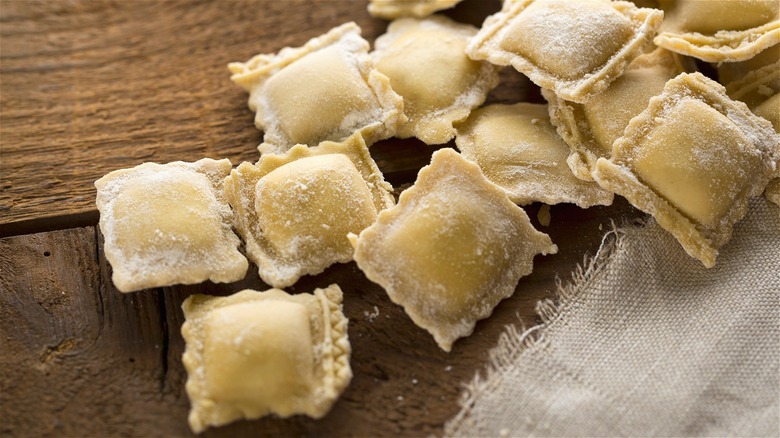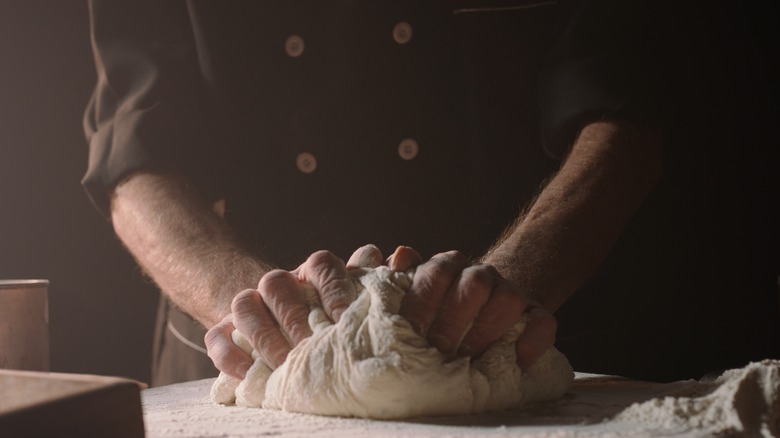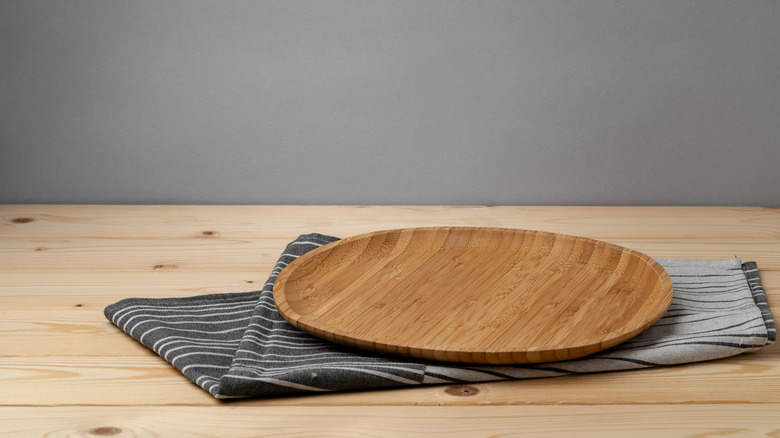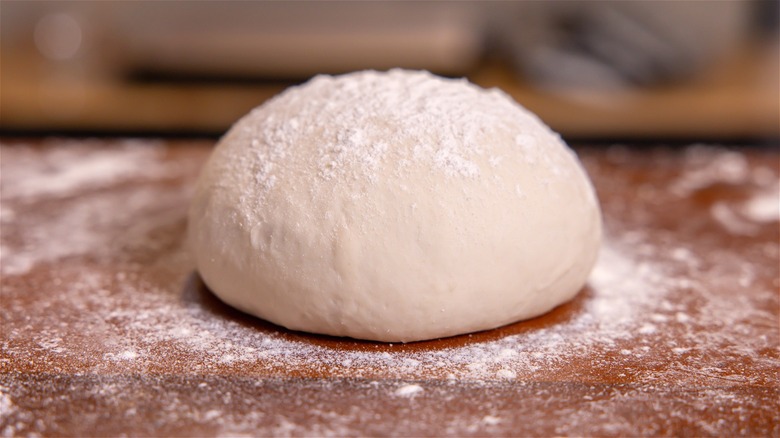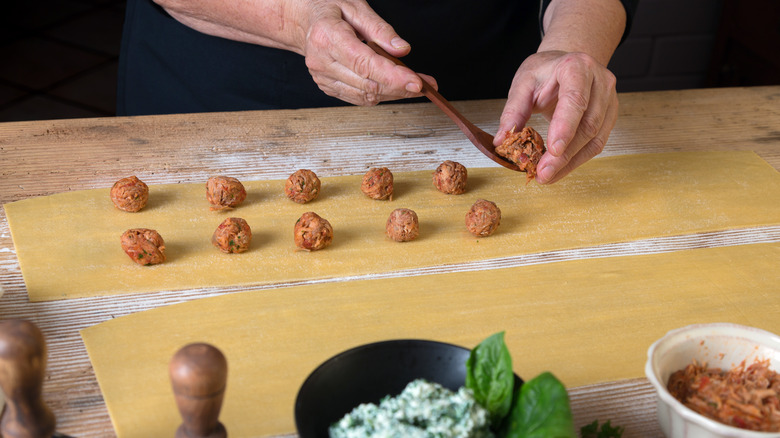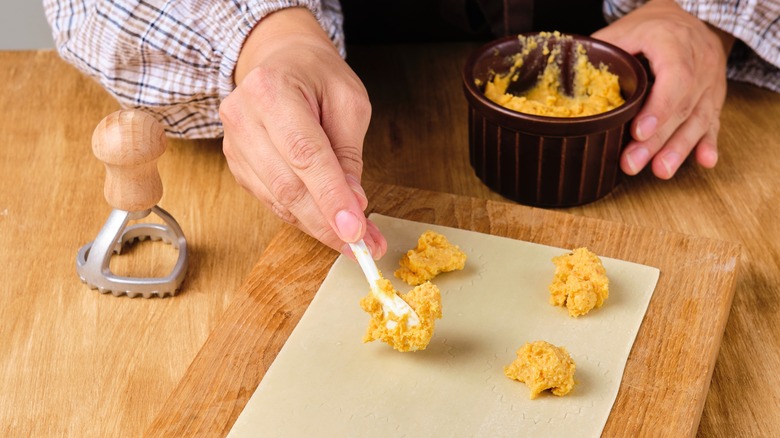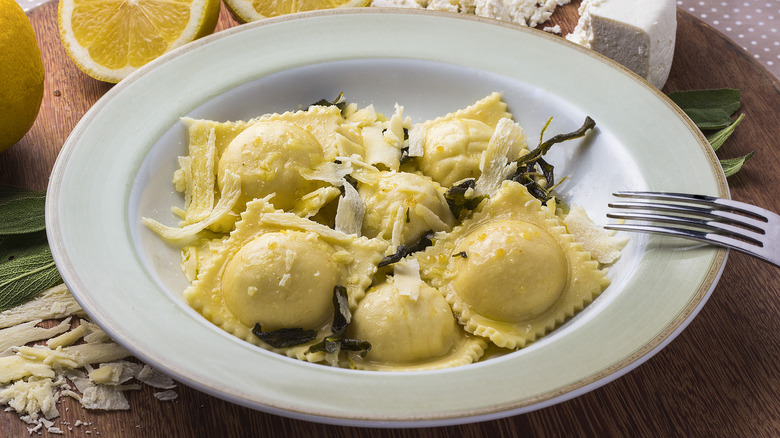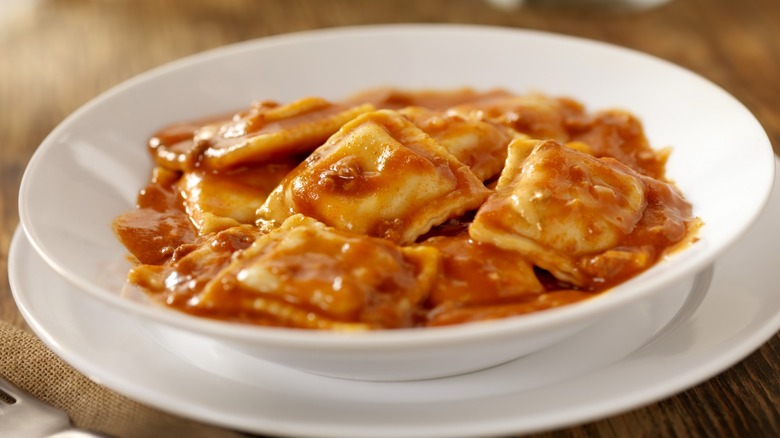7 Expert Tips For Making The Best Homemade Ravioli You've Ever Tasted
Learning how to make homemade ravioli is far from easy — and the experts know this better than anyone else. This pasta style is way more fiddly than others thanks to the filling piped into each piece. We guess that fiddliness is the price you pay for deliciousness, but it doesn't exactly make it easy to master, especially when so many mistakes can be made when making ravioli. From getting your dough wrong to misjudging your filling to overcooking the pasta, it's a minefield out here. That's why you need the pros to step in and help you every now and again.
Well, luckily, we managed to nab the best in the game. We spoke to chef Stefano Secchi from the celebrated New York City Italian restaurant Rezdôra, who will be one of the featured chefs at City Harvest BID 2024. Secchi shared some key tips and tricks with us to help first-time ravioli makers produce a quality batch and seasoned pastaiolos improve their ravioli game. Ready to make the best homemade ravioli you've ever tasted? Let's go.
1. If you're rolling your dough by hand, consider your recipe
Not all doughs are created equal, and this is especially true when it comes to ravioli dough. Although most doughs will be made with the same combination of ingredients — namely eggs, flour, and potentially a little bit of oil — the manner in which you make it differs slightly. "The recipe for the dough is incredibly important," says Stefano Secchi. "If rolling 'al mattarello,' or with a rolling pin, the dough is different versus rolling with a pasta machine," he adds.
For machine-rolled dough, Secchi begins with a base of 00 flour. This flour, which is considered one of the best types for Neapolitan pizza, has a fineness that Secchi states improves your pasta dough. While you can use all-purpose flour if you wish, you won't quite get the same result. Secchi then adds in three egg yolks and two full eggs, and follows up with a drizzle of extra virgin olive oil before he forks the mixture together. The egg yolks and olive oil give the pasta dough a rich flavor, with the yolks also providing that extra-golden hue. The fats in both ingredients also help strengthen the dough, which proves beneficial when it's being fed through the pasta machine as it helps prevent it from ripping.
2. When kneading your dough, choose your board correctly
Whether you're using a pasta machine or not to roll your dough, you'll need to pay particular attention to your kneading process. It's not just how you knead your dough that matters, either — it's what you knead it on. "Always knead on a porous board so you can limit the amount of flour you have to add," says Secchi. If you fail to do this, you'll have to constantly sprinkle flour down so that it doesn't stick, which will dry out your dough and reduce its moisture levels. A wooden chopping board will work well, or a granite or marble countertop. Conversely, kneading your dough on a non-porous laminate countertop may lead to a little trouble.
You should also consider your kneading technique carefully. Secchi likes to use a technique that he dubs "one, two, three, gira," which he demonstrates in his MasterClass (via Facebook). He presses and kneads the dough three times, before turning it ("gira" means "turn" in Italian) and then repeating the process. Doing this allows you to work the pasta dough consistently and from every angle, letting that gluten develop throughout the dough, which gives it its strength and chewiness. Don't worry too much about over-kneading the dough — Secchi says this rarely occurs — but stop when it's well-incorporated and the dough bounces right back into place when you press it with your thumb.
3. Make sure you rest your dough
After we work, we rest. That's a rule that's as true for life as it is for pasta dough, but when you're making ravioli it's especially important to heed it. Stefano Secchi recommends that you rest your pasta dough for 30 minutes. The reason for this is that it allows the dough and its gluten to relax, so when you roll it out it remains stretchy and bouncy — and not tough and overly chewy.
It's also important to think about where you're resting it. Give your refrigerator a wide berth, and instead wrap your dough in plastic wrap and leave it on the counter. If you put your dough in the fridge, the cold temperature will cause it to contract, making it less pliable and harder to roll out. The plastic wrap, meanwhile, stops it from drying out, keeping your dough lovely and moist.
When it's ready to go, you then just need to cut it into portions, press it down slightly, and begin your rolling process. If you're using a pasta machine, begin on the thickest setting and gradually reduce it until it's the thickness that you want. Ensure that you're putting any leftover pieces back in the plastic wrap, so they don't get too dry while you're rolling the other portion.
4. The key to a good filling is dryness
What's the best part of ravioli? Is it the pasta, the filling, or the sauce? In our opinion, it's the combination of the three that makes this dish sing — but if your filling isn't on point, the whole thing suffers. Somewhat ironically, while most of us want a filling that delivers a pop of glorious moisture, you don't want it to be too wet. "Very wet fillings are why doughs crack," explains Stefano Secchi. If your filling is too wet, it makes it harder for the dough to close properly, as the sides of each piece of pasta get too slick. It also may make things too moist from the inside, weakening the structure of your dough and potentially causing it to rip.
So, Secchi advises that you "make sure your filling is dry enough to prevent issues when closing." You want to make sure that your filling is smooth and pipable so that you can deposit equal amounts in each piece of pasta. What you don't want, though, is for it to be loose or dripping all over your dough. Nor do you want any large chunks causing your ravioli to become misshapen, or creating sharp edges on the inside that could rip the dough. Once your fillings are piped out, moisten the sides of the pasta with a little bit of water on the tip of your finger, to help the top layer stick.
5. Don't be afraid to experiment with your fillings
The question of what's the best ravioli filling is kind of unanswerable. In truth, the perfect ravioli filling "depends on the mood" of the maker, according to Stefano Secchi. Provided that it's the right texture and isn't too bland or bold, you can put virtually anything in your ravioli. Secchi likes to stick with some key flavors. "Prosciutto, mortadella, greens, ricotta with Parmigiano and nutmeg" are all good places to start with your fillings, he says. Prosciutto and mortadella can give ravioli a sharp, punchy flavor, while ricotta with Parmigiano and nutmeg can provide that same punchiness with a smooth undertone from the ricotta cheese.
Want to make your ravioli even more interesting? You can upgrade it with a filling inspired by spinach artichoke dip. This recipe really isn't that far away from more classic ravioli fillings, especially if you use ricotta in place of the cream cheese or mayo that's normally used in spinach artichoke dip. The artichokes in it, however, give it a nutty and earthy flavor, with the spinach providing a pop of greenness.
6. Ensure that you don't overcook your ravioli
One of the biggest mistakes people make when cooking pasta is not just overcrowding their pan, but forgetting to consider their cooking times. Fresh pasta like ravioli takes substantially less time to cook than dried pasta does — but perhaps because ravioli has a filling, people tend to overshoot their cooking times and think that it can take as long as the dried version. This is a massive error that can lead to your ravioli breaking apart in the water.
Instead, you need to time things carefully. To cook fresh ravioli, aim for just a couple minutes of cooking time, "usually 3-4 minutes in boiling, well-salted water," says Stefano Secchi. If your ravioli is frozen, it'll take slightly longer to cook. You should add around 1-2 minutes to your cooking time, to ensure that your filling is thawed and warmed all the way through. You can tell when your stuffed pasta is cooked when all the pieces float to the surface of your pot, thanks to the air inside each piece expanding and making the ravioli buoyant.
7. Keep your sauces simple
If you really want your ravioli to pop flavor-wise, you may want to exercise some restraint. It's tempting to make a rich, flavorful sauce to go with your rich, flavorful ravioli, as well as to make the dish stretch a bit further. If you do this, though, you're just going to overwhelm the ravioli and ruin all the hard work you put into it. "You want to showcase the pasta and filling," says Stefano Secchi. "Remember, the sauce in Italia is called "condimento" or condiment, the pasta is the star."
As such, Secchi recommends that you work with simple sauces. Brown butter and sage is a particular favorite of his, with the subtlety of the brown butter's nuttiness and the sage's earthy tones elevating your pasta enormously. A herb-spiked butter sauce, such as those flavored with rosemary or thyme, can also give your dish nuance without being overwhelming. You can also serve your ravioli "al brodo," which means "with broth." It's a good way to honor your pasta and keep it moist, although try not to make your broth too salty, as this will destroy any nuance provided by your filling.
